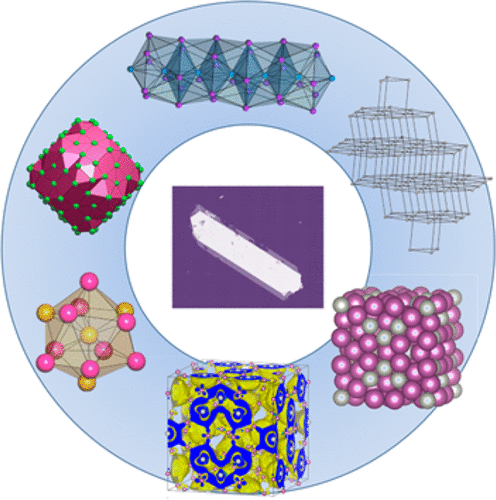当前位置:
X-MOL 学术
›
Acc. Chem. Res.
›
论文详情
Our official English website, www.x-mol.net, welcomes your
feedback! (Note: you will need to create a separate account there.)
Topology of Intermetallic Structures: From Statistics to Rational Design
Accounts of Chemical Research ( IF 16.4 ) Pub Date : 2017-12-29 00:00:00 , DOI: 10.1021/acs.accounts.7b00466 Tatiana G. Akhmetshina 1, 2 , Vladislav A. Blatov 1, 2 , Davide M. Proserpio 1, 3 , Alexander P. Shevchenko 1, 2
Accounts of Chemical Research ( IF 16.4 ) Pub Date : 2017-12-29 00:00:00 , DOI: 10.1021/acs.accounts.7b00466 Tatiana G. Akhmetshina 1, 2 , Vladislav A. Blatov 1, 2 , Davide M. Proserpio 1, 3 , Alexander P. Shevchenko 1, 2
Affiliation

|
More than 38 000 substances made only of metal atoms are collected in modern structural databases; we may call them intermetallic compounds. They have important industrial applications, and yet they are terra incognita for most of our undergraduate students. Their structural complexity and synthesis are not easily adaptable to first years laboratories, keeping them away from the standard curricula. They have been described over the years following alternative and complementary views such as coordination polyhedra, atomic layers, and polyatomic clusters. All of these descriptions, albeit relying on grounded principles, have been applied on a subjective basis and never implemented as a strict computational algorithm. Sometimes, the authors generated multiple views of the same structure reported with beautifully drawn figures and/or photos of hand-crafted models in seminal works of the precomputer age. With the use of our multipurpose crystallochemical program package ToposPro, we explored the structural chemistry of intermetallics with objective and reproducible topological methods that allow us to reconcile different structure descriptions. After computing the connectivity patterns between the metal atoms on the basis of Voronoi partitioning of the crystal space, we were able to group the 38 000 intermetallic compounds into 3700 sets of crystal structures with the same topology of atomic net. We have described the different views used in the literature and shown that 12-vertex polyhedra are the most frequent (33%) and that almost half of them are icosahedron-like (46%), followed by cuboctahedron (25%) and, unexpectedly, by bicapped pentagonal prism (13%). Looking for layers, we have found that the hexagonal lattice, which corresponds to the closest packing of spheres on a plane, exists in more than 11 000 crystal structures, confirming the close-packed nature of intermetallics. We have also applied the nanocluster approach, which goes beyond the first coordination sphere and looks for structural units as multishell clusters that assemble the whole structure. This approach shows that 41% of intermetallics can be assembled with a single nanocluster and that 22.4% of these are packed according to the face-centered cubic motif of the closest packing of spheres in three-dimensional space. We have shown that our approach can easily adopt any other building model and hence could become a platform for a universal predictive scheme. Within this scheme, all of the structural descriptors can be related to experimental data and theoretical modeling results and then can be used to synthesize new intermetallic compounds and to foresee novel materials.
中文翻译:

金属间结构的拓扑:从统计到合理设计
在现代结构数据库中,收集了超过38 000种仅由金属原子构成的物质;我们可以称它们为金属间化合物。它们在工业上具有重要的应用,但它们在世界范围内广为人知对于我们大多数的本科生。它们的结构复杂性和综合性不容易适应第一年的实验室,使它们脱离了标准课程。多年来,它们是按照诸如配位多面体,原子层和多原子团簇等替代和互补的观点进行描述的。所有这些描述,尽管都基于扎根的原理,但都是在主观的基础上应用的,并且从未实现为严格的计算算法。有时,作者在计算机时代之前的开创性作品中,用精美绘制的图形和/或手工制作的模型的照片报告了相同结构的多个视图。通过使用我们的多功能晶体化学程序包ToposPro,我们用客观且可再现的拓扑方法探索了金属间化合物的结构化学,这些方法使我们能够调和不同的结构描述。根据晶体空间的Voronoi分配计算出金属原子之间的连通性模式后,我们能够将38 000种金属间化合物归类为3700套具有相同原子网拓扑的晶体结构。我们已经描述了文献中使用的不同观点,并显示12顶点多面体是最常见的(33%),并且几乎一半是二十面体状的(46%),其次是立方八面体的(25%),并且出乎意料的是,由二尖形五边形棱镜(13%)。在寻找图层时,我们发现六角形晶格对应于平面上最接近的球体堆积,存在超过11000个晶体结构,这证实了金属间化合物的紧密堆积性质。我们还应用了纳米簇方法,该方法超越了第一个协调领域,并寻找结构单元作为组装整个结构的多壳簇。该方法表明,可以用单个纳米簇组装41%的金属间化合物,并且根据3D空间中球体最紧密堆积的面心立方图案来堆积其中的22.4%。我们已经表明,我们的方法可以轻松采用任何其他构建模型,因此可以成为通用预测方案的平台。在这个方案中,
更新日期:2017-12-29
中文翻译:

金属间结构的拓扑:从统计到合理设计
在现代结构数据库中,收集了超过38 000种仅由金属原子构成的物质;我们可以称它们为金属间化合物。它们在工业上具有重要的应用,但它们在世界范围内广为人知对于我们大多数的本科生。它们的结构复杂性和综合性不容易适应第一年的实验室,使它们脱离了标准课程。多年来,它们是按照诸如配位多面体,原子层和多原子团簇等替代和互补的观点进行描述的。所有这些描述,尽管都基于扎根的原理,但都是在主观的基础上应用的,并且从未实现为严格的计算算法。有时,作者在计算机时代之前的开创性作品中,用精美绘制的图形和/或手工制作的模型的照片报告了相同结构的多个视图。通过使用我们的多功能晶体化学程序包ToposPro,我们用客观且可再现的拓扑方法探索了金属间化合物的结构化学,这些方法使我们能够调和不同的结构描述。根据晶体空间的Voronoi分配计算出金属原子之间的连通性模式后,我们能够将38 000种金属间化合物归类为3700套具有相同原子网拓扑的晶体结构。我们已经描述了文献中使用的不同观点,并显示12顶点多面体是最常见的(33%),并且几乎一半是二十面体状的(46%),其次是立方八面体的(25%),并且出乎意料的是,由二尖形五边形棱镜(13%)。在寻找图层时,我们发现六角形晶格对应于平面上最接近的球体堆积,存在超过11000个晶体结构,这证实了金属间化合物的紧密堆积性质。我们还应用了纳米簇方法,该方法超越了第一个协调领域,并寻找结构单元作为组装整个结构的多壳簇。该方法表明,可以用单个纳米簇组装41%的金属间化合物,并且根据3D空间中球体最紧密堆积的面心立方图案来堆积其中的22.4%。我们已经表明,我们的方法可以轻松采用任何其他构建模型,因此可以成为通用预测方案的平台。在这个方案中,











































 京公网安备 11010802027423号
京公网安备 11010802027423号